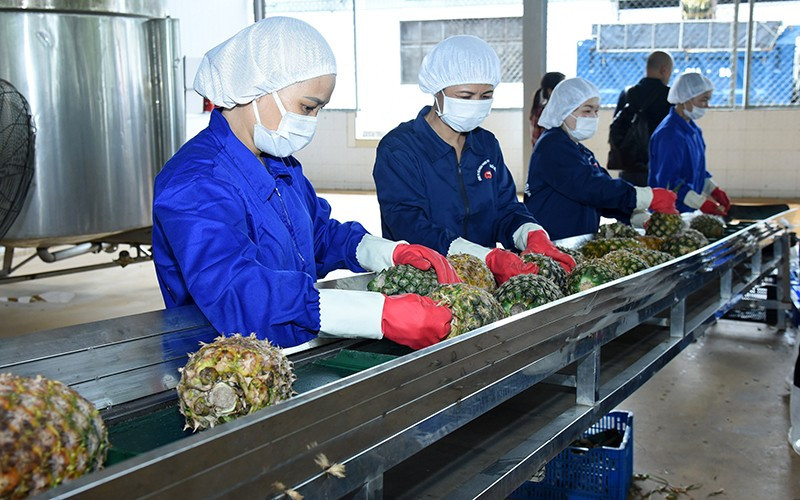These results provide strong foundations for the sector to make a breakthrough in the latter half of the year.
In the first six months of 2024, total agricultural exports rose by 19% to 29.2 billion USD, while imports reached 20.92 billion USD.
Strong growth in both production and export
MARD Deputy Minister Phung Duc Tien shared that Vietnam’s agricultural export turnover in 2024 will likely reach 54-55 billion USD. Currently there are seven exports with respective revenues exceeding 1 billion USD, namely coffee, rubber, rice, fruit and vegetables, cashew nuts, shrimp, and timber.
Rice and cashew nuts posted strong growth in both volume and value compared to 2023. Specifically, Vietnam’s rice export volume reached 4.68 million tonnes (up 10.4%), generating 2.98 billion USD (up 32%). The country also exported 350,000 tonnes of cashew nuts worth 1.92 billion USD, up 24.9% and 17.4% respectively. The export volume of coffee fell 10.5%, however its value rose by 34.6% to 3.22 billion USD thanks to a 50.4% increase in average prices.
Regarding markets, Vietnam’s agricultural exports to the Americas reached 6.6 billion USD, up 20%. The respective figures for Asia and Europe were 13.9 billion USD (up 17.8%) and 3.7 billion USD (up 32.8%). Vietnamese exports to Africa and Oceania rose by 17.1% and 18.2% to 565 million USD and 405 million USD respectively.
The US, China and Japan remained the three largest markets for Vietnamese agricultural exports, with respective shares at 20.7%, 20.2% and 6.7%.
Besides exports, agricultural production also witnessed many bright spots, which are an important factor in driving overall growth and affirming its role as a pillar of the economy. According to the General Statistics Office, Vietnam’s agricultural sector recorded bumper crops with high prices in the first half of the year, with the selling price index up 10.29% from a year ago.
Fruit and vegetables are currently the largest agricultural export thanks to higher output in the first half of 2024, with a turnover of nearly 3.5 billion USD, up 28% year on year.
For the fishery sector, output was estimated at 4.39 million tonnes during the January-June period, up 2.7% from a year ago. Such a high output helped the sector post an export revenue of 4.4 billion USD, up 7%. Shrimp and shark catfish brought in a respective 1.6 billion USD (up 7%) and 922 million USD (up 6%).
Acceleration in second half
Dang Phuc Nguyen, Secretary General of the Vietnam Fruit and Vegetable Association, stated that Vietnam has many opportunities to earn revenue of 7 billion USD in fruit and vegetable exports. China continues to be Vietnam’s primary market. Data from the Department of Export-Import under the Ministry of Industry and Trade (MOIT) showed that in the first five months of 2024, Vietnam’s fruit and vegetable exports to China reached 1.7 billion USD, up 33.4% over the same period of 2023.
Vietnam and China are expected to sign a new protocol on exporting frozen durian, passion fruit and chilli in 2024. The two countries also agreed to sign a protocol on fresh coconuts. China’s strong demand for coconuts has been rising over the years, while its domestic output can only meet 10% of current demand. Therefore, Vietnam’s fruit and vegetable exports to China are expected to continue growing strongly in the time ahead.
Vietnamese seafood exports to China also have a bright outlook for the final months of the year. According to the Vietnam Association of Seafood Exporters and Producers, China’s demand for shrimp is expected to rise again from the third quarter to serve the National Day and Mid-Autum Festival holidays. For shark catfish, the Chinese market is also recovering strongly with high demand and stable prices.
Le Van Quang, General Director of Minh Phu Seafood Corporation, said the company is looking to export its products to China — a market with a large population, a strong consumption power and a shared border with Vietnam, which helps reduce risks related to long-haul marine shipping.
Besides the Chinese market, the MOIT said it will step up agricultural exports to other key markets, including the US, Japan, and the European Union, as well as to new markets in the Middle East and Africa, to maintain export growth in the latter half of 2024.
MOIT Minister Nguyen Hong Dien noted that the world’s demand for agricultural goods such as rice, fruit and vegetables is growing increasingly large due to disrupted supply in the countries affected by armed conflicts, as well as rising geopolitical rivalry and trade war between major powers. In this context, Vietnam will push exports in the sustainable direction while ensuring national food security.
Accordingly, Vietnam will continue to negotiate, sign and upgrade free trade agreements with partners in potential markets, facilitate enterprises to diversify their products, markets and supply chains to boost exports. The MOIT will continue working with other ministries, localities and trade bodies to support enterprises in effectively taking advantage of the preferences in the trade pacts which Vietnam has signed, especially in maximising the quotas for Vietnam.
The MOIT will also work with the MARD in negotiations, especially those concerning market opening, animal and plant health inspection, and other technical requirements to facilitate Vietnamese agricultural produce to be exported more to the world.
















